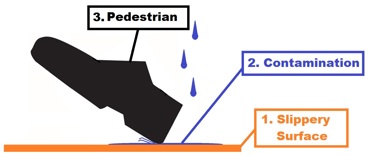Identify Spill Risks to Control Slips (Trips and Falls)
- Young shop manager awarded €47k after injuring knee in water slip
- "Shopper awarded €1.4m after slipping on grapes"
A slip on the level by a pedestrian has three critical risk factors

Spills include any material that could get onto a pedestrian surface and cause a slip. Spills can be foreseeable or unforeseeable and solid, semi-solid or liquid
- Analyse previous slips to identify any particular issues
- Use the Mapping tool designed to help identify areas where slips, trips and falls have happened and also where slips and trips are more likely to happen
- To identify spills and potential spills, consider any history of slips or near-slips.
- Actively ask staff if they have slipped or nearly slipped in any areas.
- Identify sources of
- Water, including washing areas, hand basins, drinking fountains, toilets, flowers/plants
- Rain, including external areas, rain tracked into entrances
- Water, including washing areas, hand basins, drinking fountains, toilets, flowers/plants

- Other liquids, including oil, hand disinfectant gel
- More viscous liquids can be more slippery
- Semi-solids, including soft fruits (like grapes). On decking, mildew, algae and fine mosses can be an issue
- Solids, including granular washing powder, inserts from newspapers magazines, desiccant sachet contents, etc.
- Ice can cause slips on “non-slip” surfaces

In 2009, the Slip STD Consortium proposed a classification for hard floors based on foreseeable contamination
In this video (6 min 7 sec), Steve Thorpe from HSL demonstrates pendulum slip resistance results of a dry floor, a wet floor and a “cleaned” floor
The Napo animated video "Cold case" (59 seconds) shows the hazard from a leaking pipe
This video (1 minute, 1 second) shows an animated slip on an oil spill with real-life video removing an oil spill
Spill risks are an important part of Slip Risk Assessment and Prevention
A risk assessment approach to Spills slips (trips and falls) can include the following steps
